It’s 2021. A chief of police arrives at his desk and notices a package has come through the mail. Upon opening it, he sees a broken name pin. He pulls it out, flips it over to reveal the name, and is immediately transported back to 1985.
A young boy is eating his breakfast with his siblings while watching his favorite cartoons. His father walks into the kitchen to tell the family goodbye. The boy looks over and takes in his father’s outfit: dress shoes, slacks, tie, badge, and hat. He was wearing the uniform of a Philadelphia police officer. The father hugs his family before walking out the front door. As the young boy watches his father walk away with pride, he doesn’t realize this may be the last time he sees him.
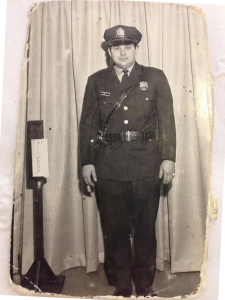
Bringing his attention back to the present, the chief immediately begins to reach out to companies who may be able to mend the broken pin. The name pin was more than just an heirloom; it was a link to the past, a reminder of the sacrifices made by those who came before, and a source of inspiration for the future.
This story is reminiscent of the Clewiston, Florida, chief of police who sent a letter to Reeves Company hoping to restore his father’s name pin from decades prior. With meticulous care, the entire team at Reeves Company breathed new life into the broken pin, honoring its storied past while ensuring its place in the future.
Chief Thomas P. Lewis’s father served the Philadelphia, Pennsylvania, community for 16 years. His legacy endured as his son followed in his footsteps to become an officer himself, who has served more than 25 years. His story also sounds familiar to Reeves Company because when founder Bob Reeves passed away, it was up to future generations to continue the family’s legacy of providing high-quality pins to police personnel.
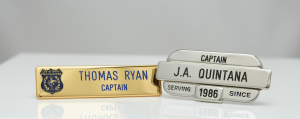
In the town known as the “Jewelry Capital of the World,” Bob Reeves honed his craft by meticulously refining the design, structure, and quality of each name pin he created. Since 1947, in the heart of Attleboro, Massachusetts, Reeves Company continued into its third generation of ownership, passing from Bob Reeves to his son and then to Bob’s granddaughter. “From customizable name pins crafted with the finest materials to a customer service team renowned for their expertise and dedication, Reeves Company stands as a testament to the enduring values of quality, integrity, and tradition,” said Rachel (Reeves) Benavides, chief executive officer.1
The story of family tradition extends to other companies within the industry as well. Hero’s Pride has manufactured patches for over 40 years. What started as a small outfit in the 1980s is still family-owned but has since grown its offerings. “We now develop, manufacture, and market not just insignia but also a full line of duty gear for law enforcement,” said Matteo Recanatini, vice president of marketing.2
The Emblem Authority has seen similar success since being founded in 2002. The company can trace its roots back several generations, starting in the 1920s when E. Henry Conrad arrived in the United States. He set up shop in New Jersey to continue what his family excelled at in Germany: embroidery. He leveraged his expertise to make emblems, specifically for the military. As business boomed, the Conrads outgrew their location and made the move to the mountains of North Carolina.
In 2002, it was determined that having a company focused solely on public safety would be the best move. “We could take our experience as embroiderers and as providers to these departments already, hone our skills in this market, and serve each department even better,” said General Manager Lisbeth Nagle, granddaughter of E. Henry Conrad.3
Identifying Trends
Emblems such as patches, badges, and name pins are often the first items community members notice on a police officer’s uniform. “It’s important that it reflects the values of the agency but also that it projects professionalism and pride,” said Recanatini. Although a patch, badge, or pin may be the smallest accessory, it can make or break a uniform, affecting the public’s impression of the officer and the agency.
There has, however, been an increasing shift away from generic and standardized imagery of flags and eagles to customized emblems. Custom imagery can better represent the city, county, state, or tribe where the police agency operates. “A higher set of expectations go hand in hand with this new trend,” said Recanatini. “[Chiefs] are becoming more and more aware of the importance of having the right patch.”
Over the past few years, there has been a dramatic increase in specialty patches. These promote causes, commemorate an event, or memorialize fallen officers. “These are where the creativity of the [police agency] and our expertise in embroidery come together to really shine,” said Nagle. The Emblem Authority’s longstanding relationship with the Pink Patch Project showcases this trend. Every year, the company creates a new patch for the project that supports those with breast cancer. “We have made patches for all causes and can help any department come up with a design that incorporates their logo with the color and icons that are specific to each cause.”
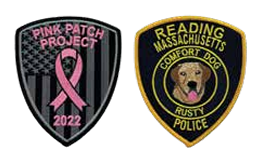
The Emblem Authority—though partial to embroidery—has acknowledged that a PVC patch could be preferred by officers for its durability. Rather than a plastic, heat seal, or Velcro backing, PVC patches offer a hook and loop attachment. This is useful for easy removal or for use on a variety of apparel and gear.
Another major player in the emblem arena, SymbolArts, used a special event as a catalyst to expand its offerings. The company seized a significant opportunity during the 2002 Winter Olympics in Salt Lake City, Utah, near its headquarters in Ogden. The event propelled SymbolArts into the spotlight as it produced pins, badges, patches, and more for local businesses and public safety agencies to celebrate the event. “Our participation was an eye-opening moment to see how custom products can be utilized for precious commemorations and the unifying power of honoring those participants,” said Marketing Manager Tess Sawaya.4
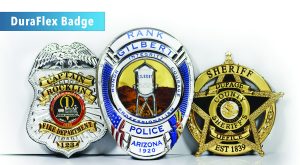
Today, SymbolArts’ sales team remains up to date with emerging trends and are encouraged to explore creative and innovative solutions with their clients. This type of collaboration brought about the introduction of the Duraflex Badge—a flexible badge with a metallic finish. The innovative design of the Duraflex Badge offers agencies a lightweight and durable option that is suitable for a wide range of uniforms, bags, and other surfaces.
Processes
Their storied pasts connect several of these companies, but their product offerings and processes can set them apart.
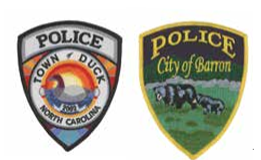
Hero’s Pride, for instance, boasts its “embroidery hybrid,” which combines traditional embroidery with woven or sublimated designs. “Blending two manufacturing techniques is not easy, but it allows us to achieve what chiefs want in their uniform patch,” said Recanatini. Sublimation (a process in which ink is heat-transferred onto a patch) is tested on different materials to find the best combination of colorfast and brilliant colors. While sublimation is great for details, Hero’s Pride enhances the patch with embroidery, which provides density and texture to a flat design. The same innovative technique can be used on woven designs as well.
Other patch-making companies often take an existing design and replicate it; however, this can often cause image inconsistencies. To avoid errors, human analysis is employed through every stage of Hero Pride’s patch development. In the planning and design stage, artists work with agencies to provide suggestions and adjustments to the patch’s image. When the artwork is approved, the design is plotted six times larger than the final product. This allows the developers to see minor details and plan production to ensure accuracy. Hero’s Pride has invested in Tajima machines and colorfast thread to produce the final product.
SymbolArts’ thorough handmade badge process also relies heavily on human analysis. Once the final artwork has been developed, the design is etched into a metal round, becoming the initial mold. Brass is then pressed into the mold with a hydraulic press. The badges are meticulously hand-cut with a jewelers’ saw, shaped, and finely sanded to achieve a smooth finish. Color is added by melting a glass mixture (cloisonne) and delicately applying it to the metal. The badge undergoes another polish and sanding to reveal the metal edges before electroplating, which involves applying metals to plate the existing brass. Two-tone badges undergo multiple rounds of electroplating. Finally, each badge is hand-polished before packaging. “While the process may not be swift, the outcome is a handcrafted work of art, uniquely tailored for each individual wearer,” said Sawaya.
Unity
Although these companies are located in separate corners of the United States, they all maintain the same idea regarding identification accessories like patches, badges, and pins: these items play a crucial role in fostering unity, publicly and internally.
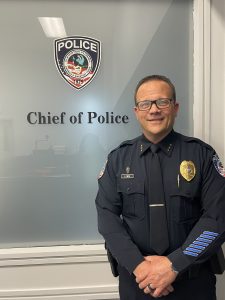
Community relationships are an important aspect of modern policing. A patch or badge can impact that relationship through first impressions. It has even become commonplace to trade patches and pins with other agencies as a sign of respect and collaboration.
“[Recognition emblems] serve as visual symbols of authority, cultivate unity and pride among officers, enhance [a] professional image, and hold historical and cultural significance within law enforcement agencies,” said Sawaya.
Think back to Clewiston’s Chief Lewis. He would have been missing a piece of his father’s legacy if the broken name pin did not reenter his life. He now carries his father’s legacy with honor as he wears the same name pin that had first adorned his father’s uniform in 1969.d
Notes:
1Rachel (Reeves) Benavides (chief executive officer, Reeves Company), email interview, April 1, 2024.
2Matteo Recanatini (vice president of marketing, Hero’s Pride), email interview, April 3, 2024.
3Lisbeth Nagle (general manager, The Emblem Authority), email interview, April 2, 2024.
4Tess Sawaya (marketing manager, SymbolArts), email interview, April 5, 2024.
Source ListPlease click on the companies’ names to go to the companies’ websites. |
|
|
Insignia Industries LLC/pinsinc.com Reeves Company, Inc. |
|
Please cite as:
“Continuing the Legacy,” Product Feature, Police Chief 91, no. 5 (May 2024): 56–57.


